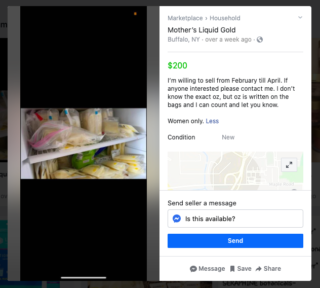
[ad_1]
“Some of the samples have such a high bacterial content that they are closer to sewage.”
Top athletes always look for an edge over their competition. Sometimes this drive will cause them to take extreme, dangerous, or even illegal measures to gain this advantage. And one of the latest trends to gain an edge? Human breast milk.

The benefits of breastfeeding are well established, and breastfeeding is highly recommended by healthcare professionals and the US Department of Health and Human Services. But it’s for babies. What about breast milk for adults? And what about breast milk as a way to gain muscle and gain muscle weight? Or breast milk to treat certain types of cancer?
Before answering any of these questions, it is best to start by asking, is it safe for adults to consume breast milk?
The Food and Drug Administration says there are a number of risks to consuming shared breast milk. These risks include “exposure to infectious diseases, including HIV, to chemical contaminants, such as certain illegal drugs, and to a limited number of prescription drugs that may be found in breast milk, if the donor was not screened adequately. Also, if breast milk is not handled and stored properly, it could, like any type of milk, become contaminated and unsafe to drink. “
Breastmilk Safety on the Internet

A quick search of the Facebook Marketplace will show you that sharing and selling breast milk is not hypothetical. This is already happening. Selling breast milk is not illegal. It is not regulated.
“When breast milk is obtained directly from individuals or via the Internet, it is unlikely that the donor has been properly screened for infectious diseases or the risk of contamination,” according to the FDA. Additionally, the FDA says it is unlikely that breast milk was collected, processed, tested, or stored in a way that reduces potential safety risks.
In an episode of the Netflix documentary series (Un) Well, “Bulking Up with Breast Milk,” these questions about the use of breast milk are raised.
Dr Sarah Keim, epidemiologist at Nationwide Children’s Hospital, was interviewed for the documentary series (Un) Well. She spoke about a study she conducted that was published in the Journal of the Royal Society of Medicine in 2015, titled “More than a lucrative liquid: the risks to adult consumers of human breast milk purchased from the online market. ”
“I don’t think there are really any circumstances where one could recommend sharing breast milk,” Keim said. “Unless you have a lab in your kitchen, you really can’t test milk yourself and know it’s completely safe.”
Keim’s warnings are not hyperbole. His study tested 102 breast milk samples from across the country and found breast milk purchased online contained detectable bacteria in 93% of the samples.
“Some of the samples have such a high bacterial content that they are closer to sewage,” she said.
The study states that “the lack of pasteurization and testing not only indicates a bacterial risk, but breast milk also exposes consumers to a multitude of infectious diseases, including cytomegalovirus, hepatitis B and C, HIV-1 / 2, HTLV-I & II and syphilis. “
Keim’s study came to the conclusion that breast milk purchased online is not optimal for adult nutrition or in treating illness because there are more risks than proven benefits.
“As adult consumers are generally not eligible for milk banks, unless the milk is from a known source – a breastfeeding partner, for example – it comes from an online source and therefore has many unknown potentials. communicable diseases. Buying online potentially exposes the consumer to bacteria, viruses and contaminants that make it a “clean” “superfood” for performance nutrition or supplementation. “
Where breast milk is needed most

However, there are some safe ways to get breast milk for babies. The FDA recommends that, if after consulting a health care provider, people who decide to feed a baby with breast milk from a source other than the baby’s mother, should only use milk from the baby. a source who has tested their milk donors and taken other precautions. to ensure the safety of her milk.
“There are breast milk banks that take voluntary measures to select milk donors and to safely collect, process, handle, test and store milk. In a few states, safety standards are required for these milk banks. FDA was not involved in the establishment of these voluntary guidelines or national standards. “
Verified milk banks can be found by organizations like Human Milk Banking, Association of North America.
There’s another concern to consider when considering whether adults should be consuming human breast milk: is there enough?
Human breast milk is always in demand. It can be vital for premature babies to receive milk rather than formula. Less than half of mothers of premature babies can provide the milk their babies need to provide nutrients, immune components and to promote growth.
During the coronavirus pandemic, screening for milk donors has become more rigorous. This made it even more difficult to maintain a sufficient supply of donor milk. Adults using breast milk potentially reduce donor supplies in milk banks and withdraw milk from premature babies who need it most.
So, for the athlete looking to gain bulk, there is more than just the effectiveness of breast milk versus performance to think about. The athlete should also consider the potential health risks and harm they can cause by using a limited amount of breast milk.
(To subscribe to Food Safety News for free, Click on here)
[ad_2]
Source link